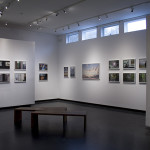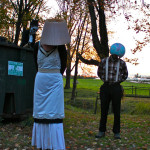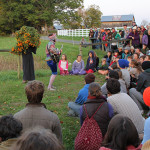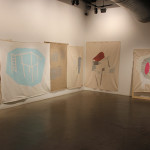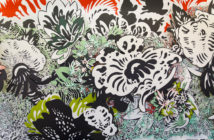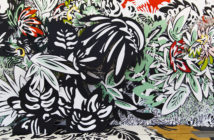A field guide to recent (and some ongoing as noted) art exhibitions and events in the greater Connecticut River region. Traveling downstream from north to south:
Marlboro, VT: Marlboro College, Drury Gallery, Jen Morris: Enunciate
Tucked away in the foothills of the Green Mountains, Marlboro College puts the "Liberal" in Liberal Arts. To me, it has always seemed a place for students to either find themselves or perhaps more likely to lose themselves in the wilderness of a self-designed academic landscape. It is fitting then, to start this "field guide" with Enunciate, a recent solo exhibition of photography by Jen Morris at the Drury Gallery at Marlboro College. In this exhibition, Jen Morris positions herself as a guide of sorts, leading us through a carefully edited tour, as if we are blindfolded only to be shown mysterious glimpses of a greater whole. The experience becomes at once delightfully intimate and distant, as if we might be seeing these things up close for the first time: a four-leaf clover, a woman’s hands, a wallpaper pattern, a window latch. There is language at work, as the exhibition title suggests. Morris codes the work with metaphor and the stripped down poetic "meter" of the images causes them to resonate so that they might even make a sound or perhaps even a new word, that can be heard up close for the first time.
Amherst, MA: UMASS University Museum of Contemporary Art, Céleste Boursier-Mougenot
I don’t know why, but there is a switch that goes off in my brain when I see a grand piano. It conjures up having to listen to endless hours of classical music on NPR and it is not that I am opposed to classical music, but I feel the grand piano is to music as the gold gilt frame is to art, it gets in the way of escaping its own history. However, in Céleste Boursier-Mougenot’s recent cerebral exhibition at the University Museum of Contemporary Art at UMASS, the grand piano derides the coattails to become a transducer of digital tickertape. In indexes (v. 1) (2012), Boursier-Mougenot has hacked into the instrument’s workings to create an algorithmic "player piano" that reads (or rather "plays") real-time stock market information as notes. Coincidentally, I read on Wikipedia, the stock market crash of 1929 played a key role in ending widespread production of the once popular player pianos back in the day.
Sadly missing though, was Boursier-Mougenot’s menagerie-like installation that pairs live Zebra Finches with Les Paul electric guitars to create a flittering audio-aviary reminiscent of the tunings up of a garage band. Originally slated to be part of this exhibition the Finches got the kibosh, as fears of an "avian flu" outbreak were raised by university officials, a little bird told me.
Amherst, MA: Amherst Biennial 2012: Art in Expected & Unexpected Places
Everybody is doing the biennial "thing" these days and Western Massachusetts is no exception. The driving force behind this sprawlingly large project, now in its second iteration, is organizer Terry Rooney. Rooney, with the necessary can-do attitude of an ex-pat New Yorker, is the kind of curator who would gladly take on the challenge of mounting an exhibition in a parking meter’s tiny window if she had the chance. The Amherst Biennial 2012: Art in Expected & Unexpected Places lives up to its name, with 45 artists and venues ranging from storefront to museum and from forest to gallery.
Some highlights included Sandy Litchfield’s fractured paintings that defy the logic the genre of "landscape" at the Eric Carle Museum (presently, Litchfield has a solo show at Carroll and Sons in Boston, through Feb. 16), Adele Mattern’s thoughtful installation "Dear Friend" at the Strong House Museum, explores the relationship between poet, Emily Dickinson and her posthumous editor (and fabled Dickinson family "home wrecker") Mabel Loomis Todd (Mattern has a forthcoming solo show at the Hampden Gallery’s Incubator Space at UMASS Jan 29-Feb. 21).
Not without its mishaps, the Amherst Biennial saw the unfortunate theft of Lee Hutt’s Rabbit, a plump and (evidently) irresistible sculpture of a bunny that was shorn from its rocky perch in Amherst’s Kendrick Park (a small setback for Amherst’s hopes for a sculpture park). Meanwhile, 17 year-old artist Peter Krasznekewicz wowed the region with his Little White Houses, which had fragments of Emily Dickinson’s poems writ large upon them. Installed at the sweeping entrance to Hampshire College (another self-directed academic utopia!) created wonderful visual poetry.
Amherst, MA: Royal Frog Ballet, Surrealist Cabaret and Pumpkin Walk
Political satire of an ecological bent, puppets, performance, and hot apple cider! This jumbled crew of thespian-artist-dancer-musician Jacks-of-all-Trades has been around for a handful of years peddling their abstract performances on the willing. And the willing are willing, the Royal Frog Ballet performed their Surrealist Cabaret to a sold out field on a farm just outside of Amherst. In the slanting October light, we followed these costumed bards, skeletons, and dancing mystics from act to act, by the barn, over a hill, and down a gully. It was a variety show of sorts, some performances were comic, like the two dancers one with a globe on his head the other with a lampshade on hers, engaging in a sweet tango number exploring perhaps, energy independence? A giant bull silhouetted against the sunset sky, a storytelling cowgirl, a large white moth flapping across a field, and ending by a bonfire with a mug of warm local apple cider. I’ve always been awed by the D.I.Y. magic of cardboard in the work of Bread and Puppet Theater, and the Royal Frog Ballet puts their own farmy spin on the great tradition of avant-garde political street theater.
North Adams, MA: MASS MoCA
Just go to MASS MoCA! Whatever is up, there is a good chance it will blow your mind! Oh, Canada, the largest survey of contemporary Canadian art outside of Canada proves we can learn a thing or two about getting art done from our neighbors to the north. See my interview with curator Denise Markonish in this month’s BR&S Journal if you haven’t already. My review of Oh, Canada can be found here. Invisible Cities, curated by Susan Cross is an intriguing exhibition playing off the psychological and conceptual nature of the built environment. Some highlights included Diana Al Hadid’s dripping cake-like Gradiva's Fourth Wall, Sopheap Pich’s bamboo and rattan Compound, and Kim Faler’s Untitled (99 44/100% Pure) which explores the interior world of the walls of the city as a ghostly stud wall built entirely out of soap, including the bent nails! Xu Bing: Phoenix. Two enormous birds fashioned out of cast off construction materials!
Holyoke, MA: Massachusetts International Festival of the Arts,
In the Round at the Victory Theatre
Here’s my review on Big Red & Shiny of this show which took place in a decrepit theater in Holyoke.
Hartford, CT: Real Art Ways, Sharon Butler: Gone Wrong and
Intimate Science
Sharon Butler, Gone Wrong
As a painter, I was instantly struck by Sharon Butler’s solo exhibition Gone Wrong the moment I walked through the
doors at Real Art Ways. The large canvases in the space almost had the feeling of being "dropped off," as if Butler would be back for them at any moment. Either tacked or leaning up against the wall, most of the paintings are un-stretched or unprimed, projecting a kind of honesty to this presentation and evoking the immediacy of decisions made in the studio. The canvases sag and pucker with wrinkles and all, and Butler lets the materiality of her craft shine through, like a chef might assemble ingredients to support the "protein" of a dish. In Butler's work Painting is that protein. In architecture, the term "reveal" refers to the perpendicular strip between a window or door and the surface of the wall surrounding it. It is a liminal step--a transition--and in the taped off schematics of her design-build geometry, it seems that for Butler, it is a kind of plastic space for formal inquiry and conceptual renovations.
Intimate Science, Andrea Grover (curator)
Two words: architectural fungus. Two more: plant printer. This clever exhibition organized by Andrea Grover brings together a group of artists who are working on the fence between art and science. In Mycotecture
Series Philip Ross grows mushrooms into a series of modular architectural building blocks. Supposedly, these fungus bricks can be a low cost and suitable alternative to many common building materials, but all I know is that this advance in toadstool domicile is going to blow the Smurfs’ minds! In Allison Kudla’s Capacity for (urban eden, human error) what looks like green slime is slowly piped out of a four axis "printer" onto a bed of white cottony looking media. The slime in fact contains plant seeds that, over the course of the exhibition, will sprout and grow in a computer-generated pattern that is based on both bacterial growth and suburban sprawl. I often find that this kind of inter-disciplinary media mashing can be both thematically fascinating and precariously balanced on the threshold of "just art trying to look like science" or vice versa. Thankfully, the work in this show proves a hypothesis that these two fields can be mutually inclusive pursuits. But then again, art is not an exact science is it?
Intimate Science is on view at Real Art Ways through March 21.
New Haven, CT: ArtSpace: A Benefit Auction for Chris Engstrom
This single event highlights the very apex of what art can achieve when a community of artists comes together in support of one of its own. Chris Engstrom, a New Haven artist and educator, who holds an MFA in painting from Yale was recently diagnosed with ALS (Lou Gehrig’s Disease), a degenerative disease that attacks the muscular and nervous systems. So, with mounting medical bills and assistive needs, his friends got together and threw a benefit auction to help him out. For the event, ArtSpace’s walls were not only filled floor to ceiling with art but the non-profit gallery was packed wall to wall with patrons, many of them fellow artists, and everybody was buying art. There was some great art to be had too. A gorgeously fretted over painting by Jessica Cuni, a clever photo of a banana with embedded spirit level by Kevin Van Aelst and at one point I was locked in a bidding war with artist Clint Jukkala over a sweet Gideon Bok painting of a Jimi Hendrix album cover. In the end, I let Clint have it, but not before driving up the price! I left with a nice print by Christopher Mir, and another by Mark Williams, and a puzzling little gouache painting by Zachary Keeting (who, by the way has a great video blog if you like visiting artists’ studios). Most importantly, I knew my purchases were going to help Chris in his battle with ALS. The night was a testament to the close-knit New Haven community of artists and their love and respect for Chris Engstrom as an artist, colleague and friend.
- Sandy Litchfield
- Jen Morris
- Royal Frog Ballet
- Royal Frog Ballet
- Kim Faler
- Sharon Butler
- Allison Kudla’s Capacity for (urban eden, human error)
- Philip Ross, Mycotecture Series









